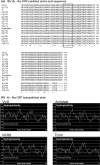Infectious bronchitis viruses with naturally occurring genomic rearrangement and gene deletion
- PMID: 21049275
- PMCID: PMC7086917
- DOI: 10.1007/s00705-010-0850-6
Infectious bronchitis viruses with naturally occurring genomic rearrangement and gene deletion
Abstract
Infectious bronchitis viruses (IBVs) are group III coronaviruses that infect poultry worldwide. Genetic variations, including whole-gene deletions, are key to IBV evolution. Australian subgroup 2 IBVs contain sequence insertions and multiple gene deletions that have resulted in a substantial genomic divergence from international IBVs. The genomic variations present in Australian IBVs were investigated and compared to those of another group III coronavirus, turkey coronavirus (TCoV). Open reading frames (ORFs) found throughout the genome of Australian IBVs were analogous in sequence and position to TCoV ORFs, except for ORF 4b, which appeared to be translocated to a different position in the subgroup 2 strains. Subgroup 2 strains were previously reported to lack genes 3a, 3b and 5a, with some also lacking 5b. Of these, however, genes 3b and 5b were found to be present but contained various mutations that may affect transcription. In this study, it was found that subgroup 2 IBVs have undergone a more substantial genomic rearrangements than previously thought.
Figures



Similar articles
-
Infectious bronchitis viruses with a novel genomic organization.J Virol. 2008 Feb;82(4):2013-24. doi: 10.1128/JVI.01694-07. Epub 2007 Nov 28. J Virol. 2008. PMID: 18045937 Free PMC article.
-
Existence of gene 5 indicates close genomic relationship of Turkey coronavirus to infectious bronchitis virus.Acta Virol. 2002;46(2):107-16. Acta Virol. 2002. PMID: 12387503
-
Identification of the avian infectious bronchitis coronaviruses with mutations in gene 3.Gene. 2008 Apr 15;412(1-2):12-25. doi: 10.1016/j.gene.2008.01.004. Epub 2008 Jan 19. Gene. 2008. PMID: 18295413 Free PMC article.
-
Complete genomic sequence of turkey coronavirus.Virus Res. 2008 Aug;135(2):237-46. doi: 10.1016/j.virusres.2008.03.020. Epub 2008 May 12. Virus Res. 2008. PMID: 18468711 Free PMC article.
-
Infectious bronchitis virus in Australia: a model of coronavirus evolution - a review.Avian Pathol. 2021 Aug;50(4):295-310. doi: 10.1080/03079457.2021.1939858. Epub 2021 Jul 15. Avian Pathol. 2021. PMID: 34126817 Review.
Cited by
-
Molecular epidemiology of infectious bronchitis virus in Poland from 1980 to 2017.Infect Genet Evol. 2020 Jun;80:104177. doi: 10.1016/j.meegid.2020.104177. Epub 2020 Jan 7. Infect Genet Evol. 2020. PMID: 31917362 Free PMC article.
-
Recombinational histories of avian infectious bronchitis virus and turkey coronavirus.Arch Virol. 2011 Oct;156(10):1823-9. doi: 10.1007/s00705-011-1061-5. Epub 2011 Jul 10. Arch Virol. 2011. PMID: 21744259 Free PMC article.
-
The presence of viral subpopulations in an infectious bronchitis virus vaccine with differing pathogenicity--a preliminary study.Vaccine. 2012 Jun 13;30(28):4190-9. doi: 10.1016/j.vaccine.2012.04.054. Epub 2012 Apr 26. Vaccine. 2012. PMID: 22542436 Free PMC article.
-
Delmarva (DMV/1639) Infectious Bronchitis Virus (IBV) Variants Isolated in Eastern Canada Show Evidence of Recombination.Viruses. 2019 Nov 13;11(11):1054. doi: 10.3390/v11111054. Viruses. 2019. PMID: 31766215 Free PMC article.
-
Distribution of infectious bronchitis virus strains in different organs and evidence of vertical transmission in natural infection.Arch Virol. 2016 Dec;161(12):3355-3363. doi: 10.1007/s00705-016-3030-5. Epub 2016 Sep 1. Arch Virol. 2016. PMID: 27586414 Free PMC article.
References
Publication types
MeSH terms
Substances
LinkOut - more resources
Full Text Sources

